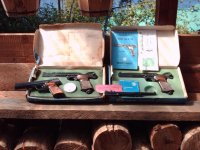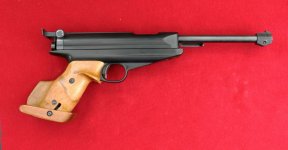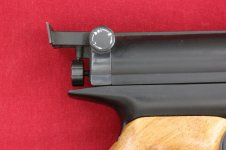What follows is a draft article on these interesting guns. Comments welcome!
John

The Smith & Wesson Models 78G and 79G pellet pistols
I'm departing a bit from my usual subject matter. I'm not writing this time about cartridge firearms, but a couple of collectible pellet guns. These are quality-made precision CO2-powered pistols once made here in the United States by the prominent gun making firm of Smith & Wesson. At first glance, you might think you are looking at one of the famed S&W Model 41 target pistols, but on closer examination, you discover these near-twins are designed to deliver pellets rather than bullets. They were crafted as companion pieces to the Model 41 that could be fired accurately indoors with less noise and penetration for a lot less money. They are getting fairly scarce on the collector market now, and not that many folks know about them today.
As the 1970s began, Smith and Wesson was determined to give the public an economical pellet gun resembling their prestige Model 41. They had hired a former Crosman Corporation engineer who had a lot of experience in the design of CO2 pellet guns. The resulting guns used a lot of the technology found in the Crosman Mark I and Mark II pistols which were introduced in 1996. However, the shape, heft and sighting arrangement of the S&W guns obviously paralleled the Model 41 .22 rimfire cartridge pistol. Two guns were introduced in 1970. These were the Model 78G in .22 caliber and the Model 79G in .177 caliber. Both were single-shot pellet guns designed to shoot skirted lead projectiles which looked like miniature badminton shuttlecocks. Manufacturing began in earnest in 1971. Production was carried out sequentially in two plants; one in Springfield, Massachusetts and another in Tampa, Florida. All guns were marked Springfield, but the actual manufacturing site may be marked on the original box. S&W ceased making these unique handguns in 1978, but they were marketed as late as 1980. About 172,000 were made and all were serial numbered. The tooling was then sold to the Daisy Manufacturing Company in Rogers, Arkansas. Similar guns were produced by Daisy as the models 780 and 790 (and later the model 41) but the quality of these particular guns never matched the superb S&W products.
The earliest guns upheld S&W's reputation for quality, and the pistols had a number of innovative features. Both the .22 and .177 guns had rifled steel barrels. On the earliest guns the trigger was adjustable for sear engagement via an Allen screw forward of the trigger. The power of the CO2 discharge was regulated with a screw just under the muzzle. When the screw was turned fully clockwise to get high power, the CO2 cartridge would provide about 65 shots and a maximum velocity of about 420 feet per second.. Turned fully counter-clockwise to get lower power, the gun was good for about 125 shots before re-charging. A charging handle much like the one on present AR-15 rifles was pulled back and a pellet was inserted in the rear of the barrel. Pushing the charging handle forward slid the pellet into position to fire. A cocking piece just above the forward edge of the trigger guard was pulled back to ready the pistol for discharge. Early guns had two clicks when this was done. The first engaged the sear, and second click put the internal hammer at full cock. Triggering after only the first click would, in actuality if not intent, allow firing at reduced velocity. A cross-bolt safety occupied the space just behind the trigger where the magazine release would be on a Model 41. The gun had to be cocked before the safety could be applied. To charge the gun with a 12.5 gram CO2 cartridge, the piercing assembly was removed from the butt by unscrewing it. A cartridge was inserted into the butt with the nipple down. Then the piercing assembly was screwed back in, and the piercing knob struck a quick blow with the palm of the hand or tapped on a bench top to release pressure into the gun.
These guns were spray-painted with a durable black finish. S&W evidently re-thought their liability issues and eliminated the 2-click sear and the sear adjustment on later guns. The rear sight mimicked the one on the Model 41 target pistol, and was fully adjustable for windage and elevation, albeit without tactile "clicks." Clockwise rotation of the two adjusting screws will move the impact of the pellet to the right and downward. Counterclockwise movement will result in left and upward impact. All of these pistols had plastic imitation walnut grips, and were provided in a box with a tin of 250 pellets, five powerlets, and an instruction booklet. The pistol illustrated is an early 79G (.177 caliber), which I estimate was made in 1971. Collectors value these early guns with their more sophisticated triggers. All were very accurate at the standard formal pellet gun range of 33 feet.
In December of 1983, the Consumer Product Safety Commission instituted a recall of all of these pistols made by S&W and Daisy. The claim was made that they could discharge if dropped under certain conditions. If a gun was recalled and modified, a "D" was stamped on the butt of the grip frame. Daisy handled all retrofits for either brand. It's rare to find one so marked. If the particular gun is not verified as retrofitted, do take care not to drop it. Of course dropping a loaded and cocked gun of any sort is never a good idea. Daisy can be contacted at 1-800-713-2479 for current information.
These Smith & Wesson target pellet guns are not toys, and they should be accorded the respect due any gun. They were and are precision instruments. Since they have been around for upwards of 30 years, it's normal for the internal seals and o-rings to deteriorate, making them unusable until reworked. Fortunately, there are a number of air gun gunsmiths who can replace the seals and o-rings and otherwise refurbish and tune them. Following that, proper air gun lubricants should be used exclusively since normal petroleum products can degrade the critical parts mentioned. Automatic transmission fluid is often recommended as a suitable substitute for the special air gun lubes. Fortunately, not much else can go wrong with these pistols, and cleaning only requires wiping them down before storage with a soft lint-free cloth. The S&W instruction booklet recommends that this type of pistol be stored with a full or partially full CO2 cartridge in place, and that the pellet chamber be empty.
Today, few have even heard of these interesting and useful Smith & Wesson guns. They do turn up occasionally at gun shows, and they are still relatively inexpensive compared to cartridge handguns. The .22 caliber Model 78G is most in demand, and the earlier guns with their better triggers command higher prices. As always, condition counts. A chipped or scratched finish is not easily restorable. A complete rig with its original box and accessories demands a good premium. Anyone looking for economical target practice with a pellet pistol that approximates the look, heft and handling of the famed Model 41 would be well served by having an example of either model.
(c) 2013 JLM
John

The Smith & Wesson Models 78G and 79G pellet pistols
I'm departing a bit from my usual subject matter. I'm not writing this time about cartridge firearms, but a couple of collectible pellet guns. These are quality-made precision CO2-powered pistols once made here in the United States by the prominent gun making firm of Smith & Wesson. At first glance, you might think you are looking at one of the famed S&W Model 41 target pistols, but on closer examination, you discover these near-twins are designed to deliver pellets rather than bullets. They were crafted as companion pieces to the Model 41 that could be fired accurately indoors with less noise and penetration for a lot less money. They are getting fairly scarce on the collector market now, and not that many folks know about them today.
As the 1970s began, Smith and Wesson was determined to give the public an economical pellet gun resembling their prestige Model 41. They had hired a former Crosman Corporation engineer who had a lot of experience in the design of CO2 pellet guns. The resulting guns used a lot of the technology found in the Crosman Mark I and Mark II pistols which were introduced in 1996. However, the shape, heft and sighting arrangement of the S&W guns obviously paralleled the Model 41 .22 rimfire cartridge pistol. Two guns were introduced in 1970. These were the Model 78G in .22 caliber and the Model 79G in .177 caliber. Both were single-shot pellet guns designed to shoot skirted lead projectiles which looked like miniature badminton shuttlecocks. Manufacturing began in earnest in 1971. Production was carried out sequentially in two plants; one in Springfield, Massachusetts and another in Tampa, Florida. All guns were marked Springfield, but the actual manufacturing site may be marked on the original box. S&W ceased making these unique handguns in 1978, but they were marketed as late as 1980. About 172,000 were made and all were serial numbered. The tooling was then sold to the Daisy Manufacturing Company in Rogers, Arkansas. Similar guns were produced by Daisy as the models 780 and 790 (and later the model 41) but the quality of these particular guns never matched the superb S&W products.
The earliest guns upheld S&W's reputation for quality, and the pistols had a number of innovative features. Both the .22 and .177 guns had rifled steel barrels. On the earliest guns the trigger was adjustable for sear engagement via an Allen screw forward of the trigger. The power of the CO2 discharge was regulated with a screw just under the muzzle. When the screw was turned fully clockwise to get high power, the CO2 cartridge would provide about 65 shots and a maximum velocity of about 420 feet per second.. Turned fully counter-clockwise to get lower power, the gun was good for about 125 shots before re-charging. A charging handle much like the one on present AR-15 rifles was pulled back and a pellet was inserted in the rear of the barrel. Pushing the charging handle forward slid the pellet into position to fire. A cocking piece just above the forward edge of the trigger guard was pulled back to ready the pistol for discharge. Early guns had two clicks when this was done. The first engaged the sear, and second click put the internal hammer at full cock. Triggering after only the first click would, in actuality if not intent, allow firing at reduced velocity. A cross-bolt safety occupied the space just behind the trigger where the magazine release would be on a Model 41. The gun had to be cocked before the safety could be applied. To charge the gun with a 12.5 gram CO2 cartridge, the piercing assembly was removed from the butt by unscrewing it. A cartridge was inserted into the butt with the nipple down. Then the piercing assembly was screwed back in, and the piercing knob struck a quick blow with the palm of the hand or tapped on a bench top to release pressure into the gun.
These guns were spray-painted with a durable black finish. S&W evidently re-thought their liability issues and eliminated the 2-click sear and the sear adjustment on later guns. The rear sight mimicked the one on the Model 41 target pistol, and was fully adjustable for windage and elevation, albeit without tactile "clicks." Clockwise rotation of the two adjusting screws will move the impact of the pellet to the right and downward. Counterclockwise movement will result in left and upward impact. All of these pistols had plastic imitation walnut grips, and were provided in a box with a tin of 250 pellets, five powerlets, and an instruction booklet. The pistol illustrated is an early 79G (.177 caliber), which I estimate was made in 1971. Collectors value these early guns with their more sophisticated triggers. All were very accurate at the standard formal pellet gun range of 33 feet.
In December of 1983, the Consumer Product Safety Commission instituted a recall of all of these pistols made by S&W and Daisy. The claim was made that they could discharge if dropped under certain conditions. If a gun was recalled and modified, a "D" was stamped on the butt of the grip frame. Daisy handled all retrofits for either brand. It's rare to find one so marked. If the particular gun is not verified as retrofitted, do take care not to drop it. Of course dropping a loaded and cocked gun of any sort is never a good idea. Daisy can be contacted at 1-800-713-2479 for current information.
These Smith & Wesson target pellet guns are not toys, and they should be accorded the respect due any gun. They were and are precision instruments. Since they have been around for upwards of 30 years, it's normal for the internal seals and o-rings to deteriorate, making them unusable until reworked. Fortunately, there are a number of air gun gunsmiths who can replace the seals and o-rings and otherwise refurbish and tune them. Following that, proper air gun lubricants should be used exclusively since normal petroleum products can degrade the critical parts mentioned. Automatic transmission fluid is often recommended as a suitable substitute for the special air gun lubes. Fortunately, not much else can go wrong with these pistols, and cleaning only requires wiping them down before storage with a soft lint-free cloth. The S&W instruction booklet recommends that this type of pistol be stored with a full or partially full CO2 cartridge in place, and that the pellet chamber be empty.
Today, few have even heard of these interesting and useful Smith & Wesson guns. They do turn up occasionally at gun shows, and they are still relatively inexpensive compared to cartridge handguns. The .22 caliber Model 78G is most in demand, and the earlier guns with their better triggers command higher prices. As always, condition counts. A chipped or scratched finish is not easily restorable. A complete rig with its original box and accessories demands a good premium. Anyone looking for economical target practice with a pellet pistol that approximates the look, heft and handling of the famed Model 41 would be well served by having an example of either model.
(c) 2013 JLM
Last edited:







